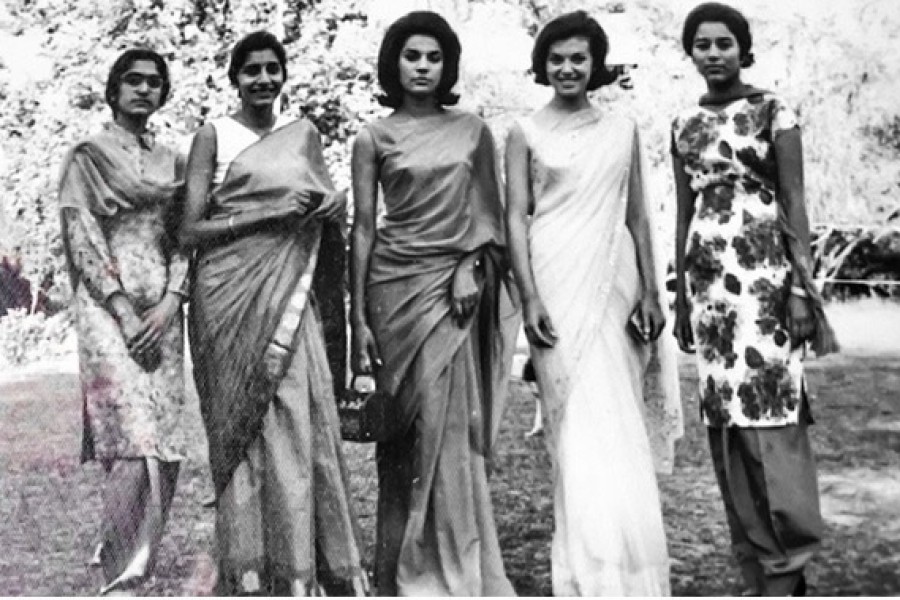“In many families at that time, wearing anything else instead of saree was a serious offence for girls. Many girls wore saree occasionally, including me. But many girls were forced to wear saree regularly to university, college and even school,” reminisced Sufia Khatun, a Zoology graduate (session honours ‘91-92) from Rajshahi University.
Reflection of Sufia Khatun's words can be found in one of the most popular dramas of the ‘80s decade- ‘Bohubrihi.’ A grandfather character of the play, Emdad Khondokar, stops his granddaughter Putul from going to school in a salwar kameez and tells her to go to school wearing a saree like a polite (!) Girl.
Some students of Dhaka University Psychology department in 1969
“I have got many married classmates in my student life. I have heard such stories from them that if they anyhow put on a salwar kameez at their father-in-law's house someday, they would have to face a serious issue like slut-shaming.” Sufia Khatun, from her personal observations, commented that in the eyes of many, the salwar kameez was very indecent and ‘modern girls' dress that time.
In many popular serials, young and unmarried girls were seen wearing saree on a regular basis. For example- Titli-Kanka of ‘Aaj Robibar’ or Muna and Bakul of ‘Kothao Keo Nei,’ or Manisha of ‘Nokkhotrer Raat.’
Gradually times changed, and many archaic ideas began to change as well. Many people disagreed with the idea that the saree is the most ‘modest’ dress for Bengali girls. And in time, the salwar kameez took its place in the Bangladeshi culture as a decent and elegant dress. The saree started to decrease. There were many reasons for this including religious and social influences.
“For me, it’s not convenient as everyday wear. Because now the lifestyle of girls is much upgraded; mostly, girls lead a busy and hectic life. It's not easy for a working girl to carry a saree for hours," Nazmoon Nahar Tuly, freelance content writer at Portland Oregon was speaking.
She added that neither Dhaka city nor this country is that women-friendly. There are no women-friendly washrooms in many places due to which wearing a saree also becomes challenging there. She also noticed that girls of her age who has already been a mother shows reluctance to wear saree, saying that maintaining such a big cloth with a baby becomes much troublesome.

Nazmoon Nahar Tuly on her scooter
However, personally, Tuly is obsessed with saree. She enjoys the trend of wearing a saree on any new occasion that is seen among the girls nowadays. She believes, a Bengali woman’s food habits and physical structure are different from other geographical regions, and saree is totally made for Bengali girls.
According to her experience, how a 50 kg girl looks in a saree, a 65 kg girl looks almost close or maybe slightly different and that’s the magic of a saree.
"In fact, saree is a lot like an investment for me. Any dress becomes backdated after one or two years. But I still have my grandmother's saree. It’s like a heritage, Maybe I'll leave mine to my daughter-in-law too.”
At the time of purchase, Tuly always prefers the hand-woven desi saree. She feels like, she’s supporting local weavers. Maybe it can be a great way to economically participate in the living cost of those talented artists.
Another reason why sarees are so popular these days is that no one cares about matching anymore. Earlier, saree needed matching blouse which was quite costly. Nowadays many women are carrying saree quite confidently with fatuwa or t-shirt instead of a blouse. The fusion of indigenous culture with Western is also gaining popularity.
Tanjim Nishat, a graduate in English Literature from Shahjalal University of Science and Technology (SUST), has found affinity towards saree due to the traditional aspects. She has reasons to believe that it symbolises her own culture.
“When I do wear saree, I feel like wearing the attire that my grandmom or my mom likes most. So, I get the feeling to get closer with them and always appreciate me with saree too as saree is not just an attire, it symbolises the culture and custom of our own root.”

Tabia Tasnim Anika recreates ‘80s look in different setups
“I used to see pictures of my mother in the nineties or earlier, almost all of them wearing saree. Gradually the flow of the saree decreased from among the mothers and aunts. But wearing saree in that old-style, moving in a carefree way used to attract me a lot,” shared Tabia Tasnim Anika, another graduate from SUST Forestry and Environmental Science. She agreed with Tanjim Nishat with the same tone of nostalgia.
“At first saree seemed a bit problematic. When I ‘inherited’ the blouses of my mother (of that time when she was of my age), I saw they were just made to my size. And after I got few more old eighties floral printed silk, and some Georgette sarees, the love for sarees increased.”
Anika not only wears a saree in a good mood but also when she’s upset and saree makes her happy magically.
Indeed there is a difference between having a saree as a regular attire in the ‘80s and in the present time. Though it’s probably the most common occasional wear in Bangladesh, the chances of saree coming up as everyday clothing are much less now. Because women now have thousands of options in the field of clothing unlike in the ‘80s.
However, many women find a new identity of themselves in the lap of this long piece of cloth. Not regular though, sarees are apparently becoming popular again.


